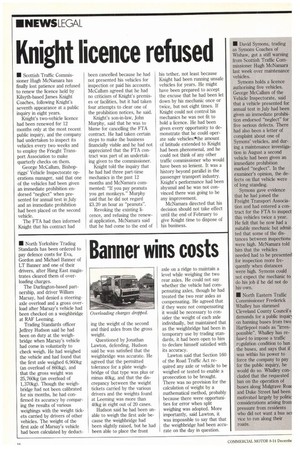Banner wins costs
Page 14

If you've noticed an error in this article please click here to report it so we can fix it.
• North Yorkshire Trading Standards has been ordered to pay defence costs for Eva, Gordon and Michael Banner of LT Banner and one of their drivers, after Hang East magistrates cleared them of overloading charges.
The Darlington-based partnership, and driver William Marsay, had denied a steeringaxle overload and a gross overload after Marsay's vehicle had been checked on a weighbridge at RAF Leeming.
Trading Standards officer Jeffrey Hudson said he had been on duty at the weighbridge when Marsay's vehicle had come in voluntarily to check weigh. He had weighed the vehicle and had found that the first axle weighed 6,960kg (an overload of 860kg), and that the gross weight was 25,760kg (an overload of 1,370kg). Though the weighbridge had not been calibrated for six months, he had confirmed its accuracy by comparing the results of various weighings with the weight tickets carried by drivers of other vehicles. The weight of the first axle of Marsay's vehicle had been calculated by deduct ing the weight of the second and third axles from the gross weight.
Questioned by Jonathan Lawton, defending, Hudson said he was satisfied that the weighbridge was accurate. He agreed that the permitted tolerance for a plate weighbridge of that type was plus or minus 40kg, and that the discrepancy between the weight tickets carried by the various drivers and the weights found at Leeming was more than 40kg in eight out of 20 cases.
Hudson said he had been unable to weigh the first axle because the weighbridge had been slightly raised, but he had been able to place the front
axle on a ridge to maintain a level while weighing the two rear axles. He could not say whether the vehicle had compensating axles, though he had treated the two rear axles as compensating. He agreed that if they were not compensating it would be necessary to consider the weight of each axle individually, but maintained that as the weighbridge had been in temporary use by trading standards, it had been open to him to declare himself satisfied with its accuracy.
Lawton said that Section 160 of the Road Traffic Act required any axle or vehicle to be weighed or tested to enable a prosecution to be brought. There was no provision for the calculation of weight by a mathematical method, probably because there were opportunities for error when split weighing was adopted. More importantly, said Lawton, it was impossible to say that that the weighbridge had been accurate on the day in question.


















































































